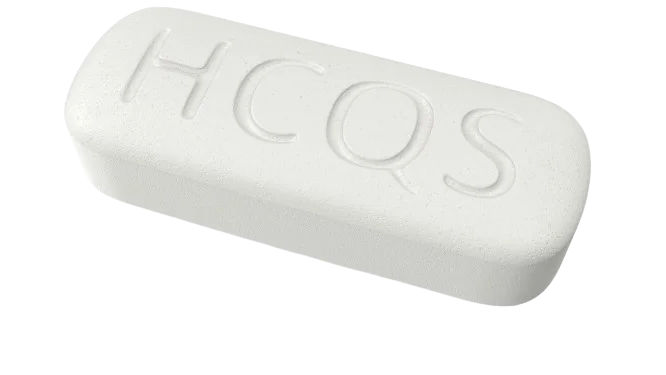What is Generic Hydroxychloroquine 200mg?
Mechanism of Action
Immune System Modulation
Hydroxychloroquine suppresses the overactive immune response by inhibiting certain immune cell functions and inflammatory pathways. It helps reduce tissue damage caused by autoimmune diseases.
Antimalarial Action
Hydroxychloroquine disrupts the metabolism of the malaria parasite (Plasmodium species) by increasing pH levels in intracellular compartments, inhibiting parasite replication.
Anti-Inflammatory Action
It inhibits the release of inflammatory cytokines and the activation of toll-like receptors (TLRs), reducing inflammation in conditions like lupus and rheumatoid arthritis.
What are the Uses and Benefits of Generic Hydroxychloroquine 200mg?
Uses of Generic Plaquenil (Hydroxychloroquine) 200 mg
Autoimmune Diseases
Rheumatoid Arthritis (RA)
It reduces joint inflammation, pain, and swelling.
Systemic Lupus Erythematosus (SLE)
It manages symptoms like rashes, fatigue, and joint pain.
Discoid Lupus Erythematosus (DLE)
Treats localized skin symptoms of lupus.
Sjogren's syndrome
It helps with symptoms like dry eyes and mouth.
Antimalarial Use
It prevents and treats malaria caused by Plasmodium vivax, P. malariae, P. ovale, and susceptible strains of P. falciparum.
Skin Conditions
It treats autoimmune skin conditions such as lichen planus and polymorphous light eruption (PMLE).
Off-Label Uses
Used off-label for:
- Chronic inflammatory conditions
- Sarcoidosis
- Post-viral arthritis
Benefits of Generic Hydroxychloroquine
Dual Action
It works as both an anti-inflammatory and antimalarial drug.
Disease-Changing Action
Hydroxychloroquine, classified as a DMARD (Disease-Modifying Anti-Rheumatic Drug), slows disease progression in autoimmune conditions.
Long-Term Use
Safe for long-term use in autoimmune conditions when monitored.
Mild Side Effect Profile
It has fewer systemic side effects.
Skin Protection
It provides benefits for photosensitivity and rashes in lupus patients.
Note:
Monitoring Required: Regular eye exams are essential, as prolonged use may cause retinal toxicity.
Adherence to Dosage: Always follow the prescribed dose to avoid side effects like gastrointestinal discomfort or vision problems.
Immune System Modulation: Hydroxychloroquine may take weeks to months to show full benefits in autoimmune conditions.
What are the Safe Dosages of Generic Hydroxychloroquine 200mg?
Standard Dosage Guidelines
- Rheumatoid Arthritis (RA)
Initial Dose
Take 400 mg to 600 mg daily (2 to 3 tablets of 200 mg) in divided doses or as a single dose.
Maintenance Dose
Take 200-400 mg daily (1 to 2 tablets), depending on response and tolerance.
- Systemic Lupus Erythematosus (SLE) and Discoid Lupus
Typical Dose
Take 200-400 mg daily (1 to 2 tablets). You can take it as a single dose or split it into twice-daily doses.
- Malaria Prevention
Adult Dose
Take 400 mg (2 tablets) once weekly, starting 2 weeks before traveling to a malaria-endemic area. Continue weekly during travel and for 4 weeks after leaving the area.
- Malaria Treatment
Initial Dose
Take 800 mg (4 tablets) as a single dose.
Follow-Up Dose
Take 400 mg (2 tablets) at 6 hours, 24 hours, and 48 hours after the initial dose (total 2 g over 3 days).
- Other Autoimmune or Off-Label Uses
Typical Dose
200-400 mg daily, depending on the condition and medical recommendation.
Weight-Based Dosage
The recommended dose is 5 mg/kg/day of actual body weight in autoimmune conditions to minimize the risk of retinal toxicity, especially in long-term use.
Children
Dosage is weight-based and determined by the doctor, especially for malaria prevention or treatment. Typically, 6.5 mg/kg/day, but not exceeding 400 mg/day.
Older Patients with compromised kidney or liver
They may require a lower dose or close monitoring because of the slower metabolism and increased risk of side effects.
Notes:
- To reduce the risk of stomach upset, take Hydroxychloroquine with a meal or glass of milk.
- Split Doses If taking a high daily dose, dividing it into two smaller doses may help improve tolerance.
- Avoid Overuse. Never exceed the prescribed dose, as overdosing can cause serious side effects, including retinal toxicity or heart rhythm disturbances.
- Monitoring During Treatment. Regular eye exams (at least yearly) are necessary for those on long-term Hydroxychloroquine therapy to monitor for potential retinal damage.
- Blood tests to check for side effects, especially in individuals with pre-existing conditions.
How to take Generic Hydroxychloroquine 200mg?
Step-by-Step Instructions
- Take it With Food or Milk
Always take Hydroxychloroquine with a meal or a glass of milk to reduce the likelihood of stomach upset, nausea, or irritation.
- Swallow Whole
Swallow the tablet whole with water. Do not crush, chew, or break the tablet unless instructed by your doctor.
- Timing
For Autoimmune Conditions
Take at the same time every day to maintain consistent levels of the medication in your body.
For Malaria Prevention
Take once weekly on the same day each week. Start 2 weeks before traveling to a malaria-endemic area. Continue during your stay and for 4 weeks after leaving the area.
- Follow Prescribed Dosage
Take as directed by your doctor. Do not adjust the dose yourself, as taking too much can lead to serious side effects.
Tips for Taking Hydroxychloroquine
- Stay Consistent. If prescribed a daily dose, make it part of your routine to avoid missed doses.
- If you miss a dose, take it as soon as you remember.
- If it is almost time for your next dose, skip the missed dose and return to your regular schedule. Do not double the dose to catch up.
- Drink plenty of fluids while taking Hydroxychloroquine to avoid dehydration and support kidney function.
Duration of Use
Autoimmune Conditions
It is a long-term treatment. Noticeable improvement can take weeks to months.
Malaria Prophylaxis
Use during exposure and continue for 4 weeks after leaving the malaria-endemic region.
Malaria Treatment
Follow the exact dosing schedule as prescribed (usually over 3 days).
Avoid These While Taking Hydroxychloroquine
Alcohol
Avoid excessive alcohol, as it may increase the risk of liver toxicity.
Direct Sunlight
Hydroxychloroquine can increase photosensitivity, so use sunscreen and protective clothing when outdoors.
Other Medications without Medical Approval
Inform your doctor about all medications, supplements, or herbal products you are using to avoid drug interactions.
Monitoring During Treatment
Eye Exams
Schedule regular eye exams (every 6–12 months) to detect early signs of retinal damage, especially with long-term use.
Lab Tests
Periodic blood tests may be required to monitor kidney, liver, or muscle health.
When Should I Avoid Generic Hydroxychloroquine 200mg or Use it Cautiously?
When to Avoid Generic Hydroxychloroquine 200 mg
Allergic Reaction or Hypersensitivity
Avoid if you are allergic to Hydroxychloroquine or related compounds like chloroquine.
Retinal or Vision Problems
Avoid if you have retinal disease, particularly conditions like macular degeneration or diabetic retinopathy. Hydroxychloroquine can cause retinal toxicity, worsening pre-existing eye conditions.
Severe Heart Issues
Avoid if you have a history of prolonged QT interval or other serious arrhythmias, congestive heart failure, or cardiomyopathy. Hydroxychloroquine may increase the risk of fatal heart rhythm disturbances.
Severe Kidney or Liver Disease
In cases of severe renal or hepatic impairment, the body may not process the medication properly, leading to toxicity.
Psoriasis
Avoid in individuals with psoriasis, as Hydroxychloroquine can worsen the condition or trigger severe flare-ups.
Porphyria
Contraindication in patients with porphyria, a rare blood disorder, as it may exacerbate symptoms.
Pregnancy
Use is generally avoided during pregnancy unless the potential benefits outweigh the risks (e.g., severe autoimmune conditions). Consult your doctor before use.
Breastfeeding
Hydroxychloroquine passes into breast milk. Doctors avoid it unless advised by a healthcare provider.
When to Use Generic Hydroxychloroquine 200 mg Cautiously
Eye Health Monitoring
Use it cautiously if you have mild visual changes or a family history of eye diseases. Long-term use increases the risk of retinal toxicity, so regular eye exams are critical.
Cardiac Monitoring
If you have a history of heart conditions, including mild arrhythmias or QT prolongation, use with caution under close medical supervision.
Existing Liver or Kidney Impairment
A doctor may alter the dosage in patients with mild-to-moderate kidney or liver dysfunction to prevent the accumulation of the drug in the body.
Blood Disorders
Patients with a history of anemia or other blood disorders should use it cautiously, as Hydroxychloroquine can rarely cause blood abnormalities like aplastic anemia or hemolysis.
Concurrent Medication Use
Use it cautiously if you are taking medications that interact with Hydroxychloroquine, such as
- Drugs that prolong QT interval (e.g., certain antibiotics or antipsychotics)
- Immunosuppressants or biologics
- Anti-seizure medications or antidiabetic drugs
Neurological Conditions
If you have a history of seizures, Hydroxychloroquine may lower the seizure threshold, so use it with caution.
Age Considerations
Children: Doses must be weight-adjusted, and accidental overdose can be fatal.
Older Patients: Use it cautiously due to increased susceptibility to side effects and pre-existing health conditions.
Key Tips for Safe Use
Regular Monitoring
Eye exams: At least once every 6–12 months.
Blood tests: Monitor liver, kidney, and blood cell counts during long-term therapy.
Avoid Excessive Alcohol
Alcohol can exacerbate liver toxicity when combined with Hydroxychloroquine.
Watch for Symptoms
Report signs of retinal toxicity (e.g., blurred vision, difficulty focusing) or heart irregularities (e.g., chest pain, palpitations) immediately.
What are the Side effects of Generic Hydroxychloroquine 200mg?
Common Generic Hydroxychloroquine 200mg Side Effects
- Nausea
- Diarrhea
- Abdominal pain or cramps
- Loss of appetite
- Rashes
- Itching or pruritus
- Increased sensitivity to sunlight
- Headaches
- Dizziness or Lightheadedness
- Visual Disturbances
- Blurred vision
- Muscle Weakness
Severe Generic Hydroxychloroquine 200mg Side Effects
- Retinal Toxicity (Vision Problems)
- Cardiac Toxicity
- Severe Allergic Reactions (Hypersensitivity)
- Neurological Symptoms
- Skin and Mucosal Reactions
- Blood Disorders
- Muscle and Nerve Weakness
- Severe Gastrointestinal Reactions
- Hepatotoxicity (Liver Damage)
- Hypoglycemia (Low Blood Sugar)



